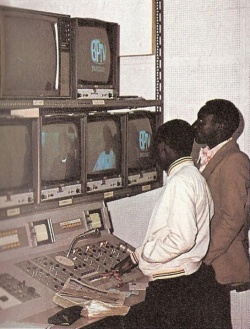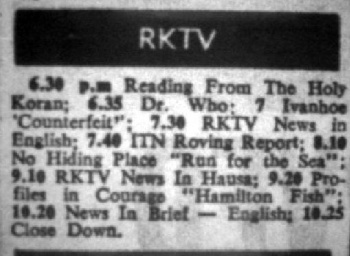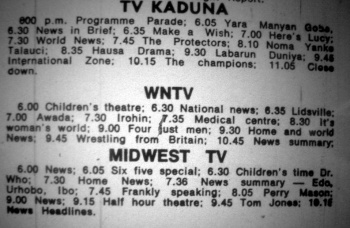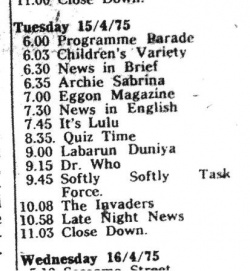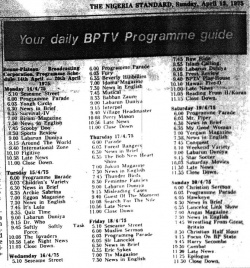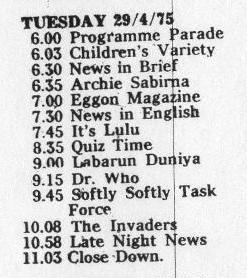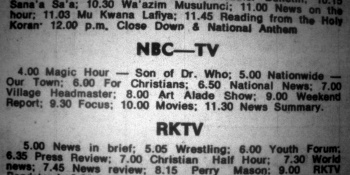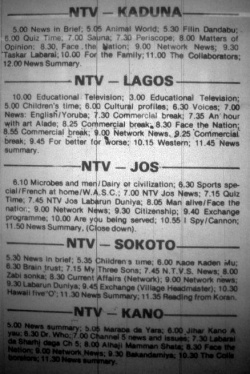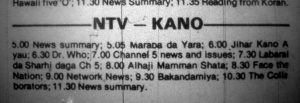Difference between revisions of "Nigeria"
Jon Preddle (talk | contribs) |
Jon Preddle (talk | contribs) |
||
| Line 157: | Line 157: | ||
====*Fate of the Prints?==== | ====*Fate of the Prints?==== | ||
| − | It is very possible that RKTV forwarded its prints of the first 26 episodes / five [[William Hartnell stories]] to [[Ghana]]. [[Ghana]] | + | It is very possible that RKTV forwarded its prints of the first 26 episodes / five [[William Hartnell stories]] to [[Ghana]]. [[Ghana]] may have sent these to [[Sierra Leone]] or back to Nigeria. (It's possible that it was intended for the programme to be bicycled around the other stations within Nigeria.) |
| − | + | It has been noted on some forums that a TV station in Africa had phoned the BBC (in the late 1990s?) to inform they had a full set of black and white episodes of '''Doctor Who''', and that after determining that it was the first two seasons, the BBC staff member told them they were not required and that they could be destroyed! It's not known what country this was, but if it was Nigeria, that could only be the case if the films had been retained for internal bicycling rather than external bicycling. | |
| + | Alternatively, the other Nigerian episodes were subsequently forwarded directly to [[Sierra Leone]], who commenced screening the series only a month after Nigeria had aired the final episode of [[The Time Meddler]]. | ||
| Line 219: | Line 220: | ||
It is not clear when this run commenced - the first listing for the series is on Monday, '''30 April 1973''', with the listing given as '''"Children's time Dr Who"''', 6.30 to 7.30pm. From the listings it looks like '''Doctor Who''' aired as part of an hour-long slot of cartoons and other children's fare. The last such listing is on '''2 July 1973'''. | It is not clear when this run commenced - the first listing for the series is on Monday, '''30 April 1973''', with the listing given as '''"Children's time Dr Who"''', 6.30 to 7.30pm. From the listings it looks like '''Doctor Who''' aired as part of an hour-long slot of cartoons and other children's fare. The last such listing is on '''2 July 1973'''. | ||
| − | Assuming there are no printing errors, this was a ten week run. If '''Doctor Who''' played for the full hour, then for some of this run, two episodes may have aired back to back. | + | Assuming there are no printing errors, this was a ten week run. If '''Doctor Who''' played for the full hour, then for some of this run, two episodes may have aired back to back. (Indeed, the fact that the prints of [[The War Machines]] recovered from Nigeria had trims from the cliffhanger of episode two and the recap at the start of part three does suggest that those two episodes had possibly been spliced together.) Otherwise only ten episodes played – as noted above, this might be [[The Web Planet]] and [[The Time Meddler]] only. |
But if there were indeed 14 episodes to account for, it's possible the newspaper did not always carry listings for MidWest, and the first four episodes of the run, being [[The War Machines]], which was the first to be sold, are omitted from the TV listings page. | But if there were indeed 14 episodes to account for, it's possible the newspaper did not always carry listings for MidWest, and the first four episodes of the run, being [[The War Machines]], which was the first to be sold, are omitted from the TV listings page. | ||
Revision as of 00:27, 29 June 2014
Profile
| Country Number (9) | 1965 | FIRST & SECOND WAVE |
| Region | Africa | Commonwealth |
| Television commenced | 31 October 1959 | |
| Colour System | 1 October 1975 | PAL |
| Population | 1966 | 52 million |
| TV Sets | 1966 | 30,000 |
| Population | 1974 | 66.174 million |
| TV Sets | 1974 | 85,000 |
| Population | 1980 | 68.750 million |
| TV Sets | 1980 | 450,000 |
| Language/s | English | regional languages |
Television Stations / Channels
Nigeria is the most-populated country in Africa.
By the mid-1960s, Nigeria was made up of 12 separate 'states' or regions, each with its own 'capital city'. (By the mid-1970s, these regions were merged into four larger states.)
Television broadcasts commenced on 31 October 1959. The Western Nigerian Government Broadcasting Corporation (WNTV) was established in October 1959, based in Ibadan, and broadcasting to the western states. WNTV was the first television service operating in 'tropical' Africa. (Northern countries like Algeria and Libya had already established TV services a few years earlier.) It commenced colour broadcasts in 1975, although it was not the first to transmit in colour (see BPTV below).
In time, each region launched its own independent television service, broadcasting foreign and locally-produced programming. The major stations, and the ones relevant to BroaDWcast, are:
- Radio-Television Kaduna / Radio Kaduna Television (RKTV): established in March 1962, based in Kaduna, and operated by the Broadcasting Company of Northern Nigeria, RKTV provided coverage to the central northern states. It was re-branded NTV-Kaduna in 1977.
- Nigerian Broadcasting Corporation (NBC): a federal government-owned service, established in April 1962, based in the then-capital city of Lagos, and broadcasting to the south western states.
- MidWest TV: the state government in Benin established a TV service from Port Harcourt in 1972.
- Benue-Plateau Television Corporation (BPTV): established in 1974, and based in Jos, in central Nigeria; it was the first to launch regular and permanent colour broadcasts in Africa (colour tests transmissions commenced 1 October 1975). The Benue Plateau Broadcasting Corporation, which was later created to control both television and radio services, was inaugurated on 25 February 1975. From May 1977, with the merger of all state television broadcasters, it was re-branded as NTV-Jos.
- NTV: in 1976, the federal government established the Nigerian Television Authority, based in Lagos, under which all the major television services across Nigeria were controlled by a single body, although each continued to broadcast its own separate schedules of programming. Although the TV stations began using their new call-letters from April 1976 - each station had the new ident NTV - formal amalgamation didn’t commence until May 1977.
Only the "rich" could afford to own a television set, but bars and restaurants often had a set for the benefit of their customers.
Language/s
Nigeria has over 235 languages and dialects, although English is the principal common language. Television broadcasts contained an equal mix of foreign programming in English, and locally-produced content in regional languages.
DOCTOR WHO IN NIGERIA
Nigeria was the ninth country to screen the series, and the first in Africa. (See Selling Doctor Who.)
BBC Records
Although BBC Records identify sales of Doctor Who to the generic name of "Nigeria", these disparate sales were to different broadcasters across the country.
The Stanmark Productions Ltd advertisement from 1966, identifies Nigeria as one of sixteen countries screening Doctor Who by January 1966.
Nigeria is named in the list of 27 countries in The Making of Doctor Who 1972 Piccolo edition.
The Seventies records a sale of "(24)" stories by 28 February 1977. The Handbook identifies these as being: A, B, C, D, E, F, G, H, J, K, L, M, N, P, Q, R, S and BB for Hartnell; and NN, PP, QQ, SS, TT, and WW for Troughton.
In DWM, Nigeria is identified in 28 story Archives: the same 24 as in The Seventies, plus 4A, 4B, 4C, and 4D, with the dates of sale recorded as 1965 as the earliest, and 1979 as the latest.
In The Eighties - THE LOST CHAPTERS, there are "(4)" sales noted for Nigeria prior to February 1987. Those likely equate to the four Tom Baker stories as noted in DWM, although it appears that far more than only four Tom Baker stories aired.
With Doctor Who screening on several different channels over the years, it appears that each station bought from the BBC whatever stories were still available at the time, hence why some of the runs of stories are disjointed.
.
.
Stories bought and broadcast
RADIO KADUNA (RKTV) (1965-1967)
WILLIAM HARTNELL
17 stories, 81 episodes:
| A | An Unearthly Child | 4 |
| B | The Daleks | 7 |
| C | Inside the Spaceship | 2 |
| D | Marco Polo | 7 |
| E | The Keys of Marinus | 6 |
| F | The Aztecs | 4 |
| G | The Sensorites | 6 |
| H | The Reign of Terror | 6 |
| J | Planet of Giants | 3 |
| K | The Dalek Invasion of Earth | 6 |
| L | The Rescue | 2 |
| M | The Romans | 4 |
| N | The Web Planet | 6 |
| P | The Crusade | 4 |
| Q | The Space Museum | 4 |
| R | The Chase | 6 |
| S | The Time Meddler | 4 |
RKTV therefore bought the standard package of William Hartnell stories, GROUPs A to E that was available to English-speaking Commonwealth countries.
The programme was supplied as 16mm black and white film prints with English soundtracks.
*Origin of the Prints?
Since Nigeria was the first African nation to buy the series, RKTV would have received fresh prints from the BBC.
Transmission
The series made its Nigerian debut on Radio-Television Kaduna / Radio Kaduna Television (RKTV), Tuesday, 3 August 1965, at 6.35pm. It stayed on that day of the week and timeslot throughout the run.
In an article / interview with William Hartnell published in the 24 April 1966 issue of the UK newspaper, Daily Mirror, it is noted that Doctor Who is "a knockout in Nigeria".
The last clear listing for Doctor Who on RKTV was on 18 April 1967 - but assuming there were no interruptions, this would be the 90th episode, nine more than the number of available episodes. We can only assume that there were nine pre-emptions during the run.
From 23 May 1967, the Doctor Who timeslot was filled by a series called The Strangers; but it's not clear on what date that started – see TV listings below.
Assuming that all 81 episodes played without interruption or pre-emption, and that the final seven listings in the papers were printing errors and should be for The Strangers, Doctor Who ended on 14 February 1967.
*Fate of the Prints?
It is very possible that RKTV forwarded its prints of the first 26 episodes / five William Hartnell stories to Ghana. Ghana may have sent these to Sierra Leone or back to Nigeria. (It's possible that it was intended for the programme to be bicycled around the other stations within Nigeria.)
It has been noted on some forums that a TV station in Africa had phoned the BBC (in the late 1990s?) to inform they had a full set of black and white episodes of Doctor Who, and that after determining that it was the first two seasons, the BBC staff member told them they were not required and that they could be destroyed! It's not known what country this was, but if it was Nigeria, that could only be the case if the films had been retained for internal bicycling rather than external bicycling.
Alternatively, the other Nigerian episodes were subsequently forwarded directly to Sierra Leone, who commenced screening the series only a month after Nigeria had aired the final episode of The Time Meddler.
TV listings
The listings for RKTV have been obtained from the Lagos newspaper, Daily Times.
All billings identify the series as "Dr Who".
Several issues did not contain listings for RKTV, and some had no TV listings at all. September to November 1966 was particularly bad for missing listings. And in April / May 1967, the lack of TV listings makes it unclear when Doctor Who ended and the replacement show The Strangers started.
MIDWEST TV (1973)
WILLIAM HARTNELL (Continued)
Three stories, 14 episodes:
| BB | The War Machines (*) | 4 |
| N | The Web Planet | 6 |
| S | The Time Meddler | 4 |
BBC Records indicate that by the early 1970s, only a handful of William Hartnell stories were still available to purchase. MidWest TV therefore bought three of these, two of which had previously screened by RKTV in 1967.
The programme was supplied as 16mm black and white film prints with English soundtracks.
(*) IMPORTANT NOTE: There is some uncertainty as to whether all three serials were sold to the same station. The BBC's clearance records have both The Web Planet and The Time Meddler being purchased by 25 July 1973 under the same invoice number, whereas the sale for The War Machines is dated two weeks earlier, by 10 July 1973, and has a different invoice number. Therefore, it's possible that the first two stories were sold together to the same station, while The War Machines was an entirely separate sale to a completely different station. The fact that only ten clear airdates have been found for this station, does support the sale of only one 6-parter and one 4-parter. (See also The Dominators below.)
*Origin of the Prints?
The film prints for The Time Meddler were sent to Nigeria from New Zealand on 2 March 1973, which was only a month ahead of the Nigerian transmission.
These episodes had been cut by the New Zealand censors. However, it appears that Mid West was responsible for removing the first few minutes of the opening TARDIS control room scene, which had the first onscreen appearance of Steven Taylor.
(An alternative is that the BBC in London sent MidWest a print of part one of The Time Meddler as part of its "Audition" process, and the print they supplied was already missing the opening TARDIS scene, an edit made by BBC Enterprises because The Chase was no longer available. New Zealand therefore may have supplied MidWest with another copy of the same episode.)
The prints of The War Machines were supplied to Nigeria from Singapore. Singapore had in turn received the prints from New Zealand; they were dispatched by the NZBC on 10 January 1972. Again, the prints had been cut by the New Zealand censors; although it appears that MidWest (or whoever the broadcaster was, if not MidWest) or the Singapore broadcaster had made further cuts to episodes two and three.
It is not known where the MidWest copy of The Web Planet came from; the serial did not screen in New Zealand due to censorship, and the fate of the film prints held by the NZBC was not recorded, but it is possible that The Web Planet was sent to Nigeria at the same time as The Time Meddler. Or, since Singapore sent The War Machines to Nigeria, they may have also been responsible for supplying The Web Planet.
A third possibility is that the film prints were supplied by Sierra Leone; those prints had previously been screened in Nigeria (RKTV) some seven years earlier!
Transmission
After a six year break, Doctor Who returned to Nigerian televisions; now screening on MidWest TV, which, despite the name, broadcast to southern regions of Nigeria.
It is not clear when this run commenced - the first listing for the series is on Monday, 30 April 1973, with the listing given as "Children's time Dr Who", 6.30 to 7.30pm. From the listings it looks like Doctor Who aired as part of an hour-long slot of cartoons and other children's fare. The last such listing is on 2 July 1973.
Assuming there are no printing errors, this was a ten week run. If Doctor Who played for the full hour, then for some of this run, two episodes may have aired back to back. (Indeed, the fact that the prints of The War Machines recovered from Nigeria had trims from the cliffhanger of episode two and the recap at the start of part three does suggest that those two episodes had possibly been spliced together.) Otherwise only ten episodes played – as noted above, this might be The Web Planet and The Time Meddler only.
But if there were indeed 14 episodes to account for, it's possible the newspaper did not always carry listings for MidWest, and the first four episodes of the run, being The War Machines, which was the first to be sold, are omitted from the TV listings page.
However, only for lack of conflicting information, we have placed the sale and transmission of all three serials as being to the same broadcaster, but it should be kept in mind that there is that doubt.
If the sale of all three serials was to the same station, the order in which they were "sold" might not reflect the order in which they aired, so the broadcast order could have been:
- The War Machines, The Web Planet, The Time Meddler, or
- The Web Planet, The Time Meddler, The War Machines
*Fate of the Prints
It was a passing comment on a 1984 radio programme that Nigerian television was so far behind the times that Patrick Troughton was still the Doctor over there that prompted Ian Levine and the BBC to contact Nigerian TV stations in the search for missing episodes. This contact resulted in the recovery of The Web Planet, The Time Meddler and The War Machines, of which episodes were missing from the BBC archives.
(The fact that all three stories were recovered at the same time has little bearing on their being screened by the same broadcaster; from 1976 all the major television services across Nigeria were incorporated and controlled by the NTV, which also took control of the film holdings of these stations. As such MidWest (and if there was 'another' station) would have forwarded their film holdings to the same central location, the facility from which the 14 films were later recovered.)
All 14 of these Hartnell episodes were subsequently returned to the BBC in 1984/85. Part one of The Time Meddler was missing parts of the opening TARDIS scene. This does not appear to have been cut in New Zealand, as the episode's running time is correct in NZBC's records. Did Nigeria cut the scene, or were they supplied with part one cut by the BBC as an Audition print?
The recovered prints of The War Machines exhibited the cuts made by the New Zealand censor, as well as additional cuts to parts two and three, which were made by Singapore or the Nigerian station, MidWest (or another…)
The BBC already held copies of The Web Planet: a set of uncut negatives and a set of prints, which were incomplete: part one was missing the opening recap from The Romans and part six had an alternative "NEXT EPISODE" closing caption. The returned "Nigerian" prints were complete and uncut.
TV listings
Listings for MidWest TV come from the New Nigerian, which was published from Kaduna. This paper only started publishing listings for MidWest from 24 April 1973, so it is unclear when exactly Doctor Who started; the first of only ten listings is dated 30 April 1973, and there are 14 episodes to account for. The "missing" four episodes may have aired in April, or, as noted elsewhere, on an entirely different station. There were no papers available for 7 May or the last three weeks of June 1973.
The six available airdates billed the series as "Children's time Dr Who".
From July 1973, New Nigerian only occasionally published MidWest TV listings.
BENUE-PLATEAU TELEVISION CORPORATION (BPTV) (1974-75)
PATRICK TROUGHTON
Four stories, 24 episodes:
| NN | The Abominable Snowmen | 6 |
| PP | The Enemy of the World | 6 |
| The Web of Fear | 6 | |
| SS | The Wheel in Space | 6 |
BPTV purchased four serials from GROUP D of the Patrick Troughton stories.
These four stories had also screened in New Zealand between September 1970 and September 1971. New Zealand did not screen The Ice Warriors or Fury from the Deep, neither of which screened in Nigeria.
Based on the way programmes were sold by the BBC at this time, it appears that the Nigeria station could only purchase those stories because they had previously been purchased by New Zealand.
(DWM's The Complete Second Doctor archive updates for these four stories all give the year of sale as 1974.)
The programme was supplied as 16mm black and white film prints with English soundtracks.
*Origin of the Prints
The film prints for The Enemy of the World and The Web of Fear had been supplied to BPTV by RTS in Singapore, who in turn had acquired them from RTV in Hong Kong in 1970. It's possible that Gibraltar and Zambia had acquired the films from Singapore first, and BPTV got the films from Zambia. (Presumably the other two Troughton stories were supplied via the same route.)
Transmission
Less than two years after the MidWest TV screenings, Doctor Who was seen in central Nigeria.
We have been unable to ascertain precisely when the run of episodes commenced (due to lack of TV listings prior to April 1975), but the final listed episode was on Tuesday, 29 April 1975, at 9.15pm. With 24 episodes to account for, and if the series ran without interruption (there may have been breaks over Christmas / New Years), it potentially could have commenced on 19 November 1974 (which certainly ties-in with the year of sale being 1974 as cited in DWM.)
Assuming that all four serials aired in the correct order, this 24 week run started with The Abominable Snowmen, and concluded with The Wheel in Space, marking the final time that these four serials aired on television...
Despite colour broadcasts commencing from October 1975, BPTV did not purchase any further episodes of Doctor Who.
*Fate of the Prints
BPTV was the last-ever television station to screen these four stories.
Prints of The Enemy of the World and The Web of Fear (episodes 1,2,4,5,6 only) were located in Nigeria (still in the ex-RTV film cans), and returned to the BBC in 2013.
TV listings
Listings are from the Jos newspaper, The Nigeria Standard. The paper was published on Sundays only, but with TV listings for the full week.
TV listings were not published prior to the 13 April 1975 issue. Only three billings for "Dr Who" were found – 15, 22, 29 April 1975. Papers were checked to the end of 1975, and no further listings were located. Therefore, we assume that these listings are for the final three of the 24 episode run.
NIGERIAN BROADCASTING CORPORATION (NBC-TV) (1975)
PATRICK TROUGHTON (Continued)
Two stories, 9 episodes (*):
| TT | The Dominators | 5 |
| WW | The Krotons | 4 |
The programme was supplied as 16mm black and white film prints with English soundtracks.
(*) IMPORTANT NOTE: BBC Records indicate that The Dominators was sold to "Nigeria" by 20 November 1975, and The Krotons by 6 February 1976. There is no certainty that both stories were sold to the same station. If both were sold together, NBC therefore bought two stories from GROUP E of the available Patrick Troughton stories.
*Origin of the Prints?
The film prints of these two serials were most likely supplied from Gibraltar.
Transmission
Only three listings for the series appear under Nigerian Broadcasting Corporation / NBC-TV: the first on Sunday, 7 December 1975, the fourth and final is four weeks later on 28 December 1975. (The 14 December paper was missing.) Given the unusual billing - "Magic Hour – Son of Dr Who" - did the programmers or editorial staff think Troughton's Doctor was the son of Hartnell's?
The billings are very ambiguous, as the timeslot is indeed a full hour. Many of the papers before and after these dates do not have programmes listed prior to 6.00pm or are missing, so it's not clear exactly how many previous or subsequent episodes of "Son of Dr Who" there may have been between November 1975 and March 1976, which happen to be the two months identified in BBC records for when Doctor Who had been sold to Nigeria.
Further research into the name "Son of Dr Who" has revealed that there may have been a children's magician who performed under that stage-name. In his online biography, Dr. Oluaiye Mobolaji Alimi Salami Naibi Oba Ogboni, reports that he studied magic in London, and on returning to Nigeria, "was the in-house magician performing on NTA Channel 10 with late Professor Peller and son of Dr. Who between 1976 – 1978."
This implies that Dr Ogboni, Professor Peller and Son of Dr Who were three stage magicians performing together on NTA's Channel 10. Of course that would make it an extreme coincidence that a magician called "Son of Dr Who" was appearing on television around the same time that Doctor Who should also have been on, and for which separate listings could not be located.
We have checked with various Colleges of Magic, and none has any record of a Nigerian magician using the stage-name "Son of Dr Who". Also, NTA didn't exist until 1976, so the biographer also has the channel and year incorrect.
Our instinct here is that "Son of Dr Who" is indeed Doctor Who, and that Ogboni's biographer has simply got his/her facts slightly askew; when they say Ogboni appeared with the late Professor Peller and son of Dr Who they mean that he was on television in the same hour of programming that included a magic show and Doctor Who.
Given that there is a three month gap between the sales dates of the two stories, there is a very high possibility that the sales of The Dominators and The Krotons were to two different stations; the December 1975 "Son of Dr Who" billings may have been for The Krotons, whereas The Dominators may have aired several months earlier, and maybe even on an entirely different station. If that is indeed the case, we have been unable to identify that station and the transmission dates…
It could be a simple case of NBC-TV initially purchasing and screening just The Dominators to begin with (per the airdates summarised here), then purchasing and screening one further story, The Krotons, a few months later.
However, only for lack of conflicting information, we will consider the sale to and transmission of both series as being of the same broadcaster.
*Fate of the Prints?
Nigeria was the final country to screen these two Troughton serials. The films were retained, returned or destroyed. (Given Nigeria's track record for the number of episodes that have been recovered from that country, the first is the more likely!)
TV listings
The billings for NBC-TV have been obtained from the New Nigerian, which was published from Kaduna. Listings for that channel were infrequent, and prior to the four listings that have been ascertained, the paper only printed programming that was after 6.00pm (with "Magic Hour - Son of Dr Who" screening at 4.00pm, it was therefore missing from the previous listings) while in the next nine weeks after the last of the "Son of Dr Who" listings, the paper was either missing or didn't include listings for NBC-TV.
These four episodes are therefore the start, middle or end of a run of episodes that potentially included either of or both The Dominators and The Krotons.
NTV-KANO (1979-1980)
TOM BAKER
Although The Eighties reports a sale of only four stories up to 1987, it is clear from the airdates, that far more stories aired. As far as can be determined, NTV-Kano screened Tom Baker's first three seasons only:
17 stories?, 72 episodes?
| 4A | Robot | 4 |
| 4B | The Sontaran Experiment | 2 |
| 4C | The Ark in Space | 4 |
| 4E | Genesis of the Daleks | 6 |
| 4D | Revenge of the Cybermen | 4 |
| 4F | Terror of the Zygons | 4 |
| 4H | Planet of Evil | 4 |
| 4G | Pyramids of Mars | 4 |
| 4J | The Android Invasion | 4 |
| 4K | The Brain of Morbius | 4 |
| 4L | The Seeds of Doom | 6 |
| 4M | The Masque of Mandragora | 4 |
| 4N | The Hand of Fear | 4 |
| 4P | The Deadly Assassin | 4 |
| 4Q | The Face of Evil | 4 |
| 4R | The Robots of Death | 4 |
| 4S | The Talons of Weng-Chiang | 6 |
NTV-Kano may therefore have bought GROUPs A to C of the Tom Baker stories.
The episodes would have been supplied on PAL colour video tapes (most likely U-Matic), with English soundtracks.
Transmission
Doctor Who returned to Nigerian TV screens in 1979. The entire Jon Pertwee era was skipped, and instead viewers saw Tom Baker's fourth Doctor.
Colour broadcasts had commenced in Nigeria in 1975 (by BPTV and WNTV, then elsewhere in later years). By 1979 all Nigerian television stations were under control of the Nigerian Television Authority, and all TV stations pre-fixed with NTV (identified stations included NTV-Kaduna (previously RKTV – see above), NTV-Lagos, NTV-Jos (previously BPTV – see above), NTV-Sokoto and NTV-Kano.)
This new run of colour Doctor Who aired on NTV-Kano.
As far as we can tell, the first episode was on Monday, 8 January 1979. (We are unsure as to the exact start date, as there was no listing for NTV-Kano in the 1 January paper.) BBC Records indicate the first four stories were Robot, The Sontaran Experiment, The Ark in Space and Revenge of the Cybermen.
The series screened weekly at 6.30pm. The run lasted for 72 weeks, from 8 January 1979 to 19 May 1980. For 11 dates during the run, something else was listed in that slot. But the listings for "Marine Biology", "Young World", "Komai da Ruwanka" (*) and "A Gani Na" (*) may be symptomatic of the duplication errors that affected the New Nigerian back in 1974.
But the fact that 72 is also the same episode-count for Robot to The Talons of Weng-Chiang does suggest that these were the stories that aired. But if so, why do the BBC Records list sales of only four season 12 stories prior to 1987? (Our thoughts here are that the BBC records used to compile the 1987 list were incomplete, and only sales to Nigeria to the end of 1978 (i.e. four stories) were documented.)
(*) These two programmes are in Chadic, a language spoken in Ghana and Nigeria; the former literally translates as "Everything that your water" (whatever that means!) and the latter as "How to see". A Gani Na is listed in the 6.30pm slot through until the end of August 1980.
There is no clear record that Nigeria screened Doctor Who again after May 1980.
TV Listings
These listings are also from the New Nigerian. All billings are given as "Dr Who". There was no listing for NBC-Kano in the 1 January 1979 paper, so it's possible the series commenced earlier than 8 January.
Airdates
| ← AIRDATES ...... (CLICK ICON TO GO TO TABLE SHOWING EPISODE BREAKDOWN AND AIRDATES - N/S = story title is Not Stated) |
We have accounted for all 200 airdates for Doctor Who that screened in Nigeria between 1965 and 1980, ten of which are "repeats" of The Web Planet and The Time Meddler.
Nigeria in Doctor Who
- Gravitron Moonbase crewman Ralph deBayo (played by Mark Heath) wears a Nigerian flag (albeit upside down!) on his tunic (The Moonbase).
